Table of Contents
Poetry with Cats
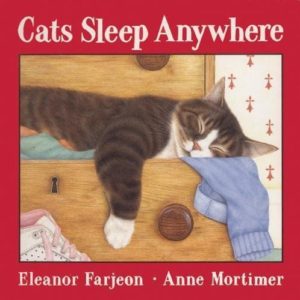
|
Eleanor Farjeon’s Cats Sleep Anywhere (Frances Lincoln Children’s Books, 2010), illustrated by painter Anne Mortimer, is a lovely simple poem (“Cats sleep/Anywhere/Any table/Any chair”). For ages 3-6. |
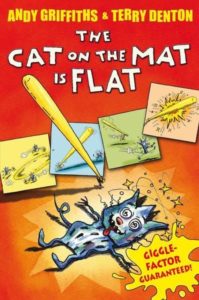 |
Andy Griffiths’s The Cat on the Mat is Flat (Square Fish, 2009) is a collection of nine zany illustrated rhymes, the first of which involves a cat, a mat, a rat, and a baseball bat. A hoot for ages 4-9. |
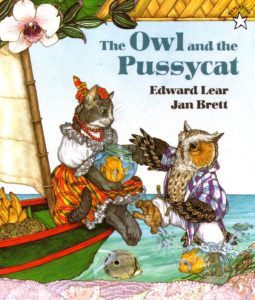
|
In Edward Lear’s The Owl and the Pussycat (Puffin, 1996), illustrated by Jan Brett, the famous couple’s pea-green boat floats through the clear waters of the Caribbean beneath which – right along with the Owl and the Pussycat – a pair of yellow fish are also falling in love. For ages 3 and up. |
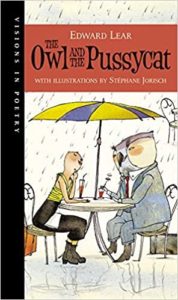 |
As illustrated by Stephane Jorisch, The Owl and the Pussycat (Kids Can Press, 2007) in the Visions in Poetry series features an upper-class business-man-like Owl and a free-spirited Pussycat who run away from it all and live happily ever after. All ages. |
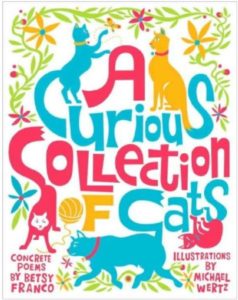
|
Betsy Franco’s A Curious Collection of Cats (Tricycle Press, 2009) contains 34 delightful and brightly illustrated concrete poems in a range of styles from haiku to limerick. (Also, just to be fair, see Franco’s A Dazzling Display of Dogs.) For ages 4-8. |
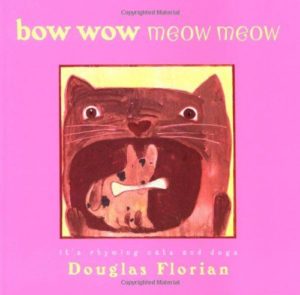
|
Douglas Florian’s Bow Wow Meow Meow: It’s Rhyming Cats and Dogs (Harcourt Children’s Books, 2003) is a collection of 21 illustrated humorous poems, variously celebrating cats and dogs, as well as the wolf, the leopard, the lion, the ocelot, the black panther and the cheetah. For ages 5-10. |
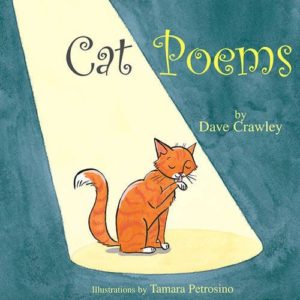
|
Dave Crawley’s Cat Poems (Wordsong, 2005) is an illustrated collection of – yes – 24 cat poems, among them “Playground Cat,” “Finicky Felicia,” “Mixed-Up Max,” and the poignant “Tandy Is Twenty.” Try this snippet: “My cat can’t read, can’t read a word/(To think he could would be absurd)/Yet every time I read a book,/he scrambles up to take a look.” Crawley is also the author of Dog Poems (2007). Both for ages 6-9. |
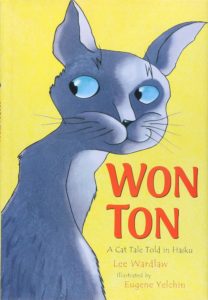
|
Lee Wardlaw’s Won Ton: A Cat Tale Told in Haiku (Henry Holt and Company, 2011) is a clever and heartwarming tale of a blue-eyed shelter cat and his adoption by a boy, related in haiku (well, senryu). The action begins in the Shelter (“Nice place they got here./Bed. Bowl. Blankie. Just like home!/Or so I’ve been told.”) and ends with the little cat happily settled in his new home, where he finally tells the boy his real name. It’s not Won Ton; it’s Haiku. For ages 4-8. |
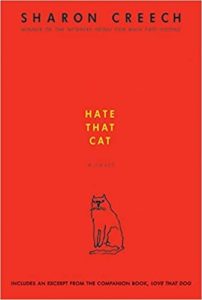
|
In Sharon Creech’s Hate That Cat! (HarperCollins, 2010), a sequel to the wonderful Love That Dog, Jack and his perceptive teacher Miss Stretchberry return for more poetry and self-exploration. Jack deals with a hateful black neighborhood cat, his critical and opinionated Uncle Bill, his feelings for his deaf mother, and his love for his new Christmas kitten – which disappears, only to be safely returned by the now-no-longer-hateful black cat. Featured poems are by Edgar Allan Poe, T.S. Eliot, Alfred, Lord Tennyson, William Carlos Williams, Valerie Worth, and Walter Dean and Chris Myers. Jack’s poem in imitation of Poe’s “The Bells,” “The Yips” (“Hear the dogs with their yips/Squeaky yips”) is priceless. For ages 9-12. |
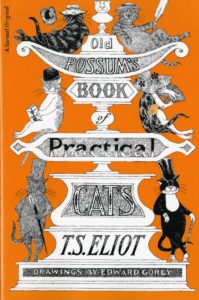
|
T.S. Eliot’s poetic celebration of cats, Old Possum’s Book of Practical Cats (Harcourt, Brace & Company, 1982), is available in several editions, but my favorite is this one, with wonderful pen-and-ink illustrations by Edward Gorey. The poems include “The Naming of Cats,””Growltiger’s Last Stand,” “The Song of the Jellicles,” “Old Deuteronomy,” and “Macavity: The Mystery Cat.” Originally written in the 1930s, this book was the inspiration for Andrew Lloyd Webber’s popular musical Cats. |
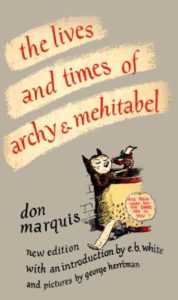
|
In Don Marquis’s classic archy and mehitabel (Anchor Books, 1987), originally published in 1916, Archy – poet and cockroach – communicates with the author by leaping on the keys of his typewriter. (No capital letters; Archy can’t use the shift key.) The book is a wonderful collection of free-verse stories about Archy’s world and friends, among them Mehitabel, a personality-laden alley cat, whose motto is “toujours gai.” For teenagers and adults. |
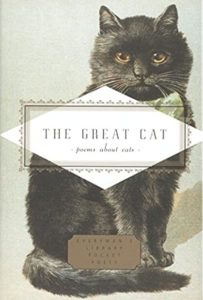 |
Edited by Emily Fragos, The Great Cat (Everyman’s Library, 2005) is a 256-page anthology of cat and cat-related poems by such poets as William Blake, Edward Lear, Oscar Wilde, W.B. Yeats, Emily Dickinson, Pablo Neruda, William Shakespeare, and Mother Goose. For teenagers and adults. |
| Poems About Cats is an illustrated collection, among them “The Cat and the Moon” by William Butler Yeats, “See the Kitten on the Wall” by William Wordsworth, “The Naming of Cats” by T.S. Eliot, “Cat Math” by Ruth Berman, and more. | |
| In Carl Sandburg’s poem Fog, “The fog comes/on little cat feet.” | |
| See Christopher Smart’s 18th-century cat poem, For I Will Consider My Cat Jeoffrey. | |
| Eugene Field’s The Duel describes the epic battle between the gingham dog and the calico cat. | |
| See Wordsmith for background and a limerick about the battling Kilkenny cats. (“There once were two cats of Kilkenny/Who thought there was one cat too many…”) |
